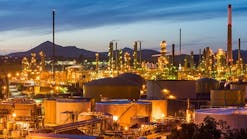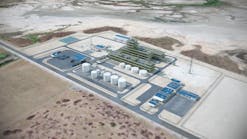Kazakhstan’s state-owned JSC National Co. KazMunayGas (KMG) is on schedule to commission subsidiary Pavlodar Petrochemical Plant LLP’s (PPP) newly reconstructed refining and petrochemical complex in Pavlodar, Kazakhstan, by the month’s end.
Part of KMG’s ongoing revitalization and modernization program of its three Kazak refineries, PPP’s Pavlodar refinery is due to be cleared for technical startup on Oct. 26, KMG said.
Alongside installation of two diesel hydrotreating reactors to enable production of diesel fuels conforming to the Eurasian Economic Commission’s technical specifications for the K5 emission class—equivalent to Euro 5-quality environmental standards—the Pavlodar reconstruction also entailed revamp and overhaul of the refinery’s:
• Atmospheric distillation unit (ELOU-AT).
• Catalytic reforming unit.
• Naphtha hydrotreating unit.
• Kerosine hydrotreating unit.
• Diesel fuel units.
Additionally, the modernization work involved reconstruction of the fluid catalytic cracking unit at the refinery’s deep oil refining complex, including replacement of upper bottoms (domes), cyclones, and unidentified internals of Reactor P-201 and Regenerator P-202, as well as replacement of unidentified internals of the unit’s K-201 fractionation column.
Project history, overview
Initiated under Kazakhstan’s 2010-14 investment plan passed in 2010 to revamp the republic’s refining sector by boosting the country’s overall crude distillation capacity to 18.5 million tonnes/year and improving the quality of products from its three refineries to conform to Euro 4 and 5-equivalent environmental standards, the Pavlodar overhaul intends to boost crude processing capacity of the plant to 7 million tpy from its nameplate capacity of 6 million tpy (OGJ Online, Oct. 30, 2014).
A first phase of the modernization project consisting of two processing units was scheduled to be commissioned by Jan. 1, 2016, at which time the refinery was to be able to produce K4-standard fuels, while a second phase focused on improving both the yields and qualities of the refinery’s petroleum product slate was due by yearend.
As originally planned, the Pavlodar modernization program was to include the revamp of ten of the plant’s units, including its crude distillation unit, vacuum distillation unit, kerosine hydrotreater, diesel hydrotreater, Merox unit, naphta hydrotreater, vacuum gas oil unit, FCC unit, catalytic reforming unit, as well as utilities, and off sites.
New installations to be built as part of the project were to include a Penex isomerization unit, sulfur recovery unit, sour water stripper, amine regeneration unit, and diesel hydrotreating and dewaxing units.
Designed to process a West-Siberian blend of crudes but reconfigured as part of the overhaul to process Kazak grades as well, the Pavlodar refinery processed only 5.1 million tpy of crude in 2016, KMG said in its 2016 annual report.
KMG did not disclose a timeframe for when—or if—the refinery would ramp up to its presumably new 7 million-tpy processing capacity following the reconstruction project.
While modernization work remains under way at KMG subsidiary Atyrau Oil Refinery LLP’s 5 million-tpy Atyrau refinery, PetroKazakhstan Oil Products LLP—a joint venture of KMG and China National Petroleum Corp.—recently commissioned a 600,000-tpy naphtha isomerization unit as part of the first phase of the long-planned upgrade of its 5.25 million-tpy Shymkent refinery in Kazakhstan (OGJ Online, July 3, 2017; July 12, 2016; Jan. 31, 2014).
Contact Robert Brelsford at [email protected].


